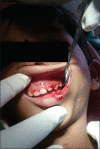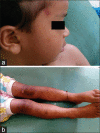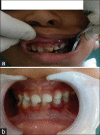Management of Dentoalveolar Trauma in a 3-year-old Child with Glanzmann's Thrombasthenia, a Rare Bleeding Disorder: Case Report and Review
- PMID: 32015657
- PMCID: PMC6975006
- DOI: 10.4103/ccd.ccd_137_18
Management of Dentoalveolar Trauma in a 3-year-old Child with Glanzmann's Thrombasthenia, a Rare Bleeding Disorder: Case Report and Review
Abstract
Glanzmann's thrombasthenia (GT) is a rare inherited bleeding disorder characterized by disturbed ability of the blood platelets to gather around the site of a broken blood vessel and fail to form a plug to stop bleeding due to deficiency of a glycoprotein IIb/IIIa in the process of blood clotting and results in moderate-to-severe bleeding on slightest injury to blood vessels. It is typically diagnosed in infancy or early childhood due to mucocutaneous bleeding tendencies. Treatment goals in GT are aimed at control of bleeding. Dentoalveolar trauma in patient with bleeding disorder poses a challenge in pediatric dentistry. The present article reports the successful management of subluxation dental injury in a 3-year-old child with "Glanzmann's thrombasthenia associated with sickle cell anemia." A narrative review of GT is given highlighting the importance of preventive dentistry and anticipatory guidance to reduce potential complications in such patients.
Keywords: Bleeding disorders; hemostatic agent; luxation injuries.
Copyright: © 2019 Contemporary Clinical Dentistry.
Conflict of interest statement
There are no conflicts of interest.
Figures



Similar articles
-
Dental Considerations in the Management of Glanzmann's Thrombasthenia.Int J Clin Pediatr Dent. 2010 Jan-Apr;3(1):51-6. doi: 10.5005/jp-journals-10005-1054. Epub 2010 Apr 15. Int J Clin Pediatr Dent. 2010. PMID: 27625557 Free PMC article.
-
Clinico-hematological and thromboelastographic profiles in glanzmann's thrombasthenia.Blood Coagul Fibrinolysis. 2020 Jan;31(1):29-34. doi: 10.1097/MBC.0000000000000870. Blood Coagul Fibrinolysis. 2020. PMID: 31789664
-
Hematological and surgical management in Glanzmann's thrombasthenia: a case report.J Indian Soc Pedod Prev Dent. 2014 Apr-Jun;32(2):181-4. doi: 10.4103/0970-4388.131000. J Indian Soc Pedod Prev Dent. 2014. PMID: 24739923
-
Glanzmann's thrombasthenia in pregnancy: a case and review of the literature.Am J Perinatol. 1999;16(6):297-301. doi: 10.1055/s-2007-993875. Am J Perinatol. 1999. PMID: 10586983 Review.
-
Severe juvenile vaginal bleeding due to Glanzmann's thrombasthenia: case report and review of the literature.Am J Hematol. 1998 Mar;57(3):225-7. doi: 10.1002/(sici)1096-8652(199803)57:3<225::aid-ajh8>3.0.co;2-x. Am J Hematol. 1998. PMID: 9495374 Review.
Cited by
-
Dental Management of Seven-Year-Old Child With Glanzmann Thrombasthenia: A Case Report.Cureus. 2024 Sep 26;16(9):e70243. doi: 10.7759/cureus.70243. eCollection 2024 Sep. Cureus. 2024. PMID: 39463654 Free PMC article.
References
-
- Rosas RR, Kurth MH, Sidman J. Treatment and outcomes for epistaxis in children with Glanzmann's Thrombasthenia. Laryngoscope. 2010;120:2374–7. - PubMed
-
- Lupien G, Amesse C, Bisonette D, Lacroix S. Glanzmann thrombasthenia – An inherited bleeding disorder. In: Page D, editor. An Information Booklet. 1st ed. Vol. 1. Canada: Canadian Association of Nurses in Heamophilia Care; 2001. pp. 4–14.
-
- Nurden AT, Ruan J, Pasquet JM, Gauthier B, Combrié R, Kunicki T, et al. A novel 196Leu to pro substitution in the beta3 subunit of the alphaIIbbeta3 integrin in a patient with a variant form of Glanzmann thrombasthenia. Platelets. 2002;13:101–11. - PubMed
-
- Nurden AT, Fiore M, Nurden P, Pillois X. Glanzmann thrombasthenia: A review of ITGA2B and ITGB3 defects with emphasis on variants, phenotypic variability, and mouse models. Blood. 2011;118:5996–6005. - PubMed
-
- Di Minno G, Coppola A, Di Minno MN, Poon MC. Glanzmann's thrombasthenia (defective platelet integrin alphaIIb-beta3): Proposals for management between evidence and open issues. Thromb Haemost. 2009;102:1157–64. - PubMed
Publication types
LinkOut - more resources
Full Text Sources
Miscellaneous

